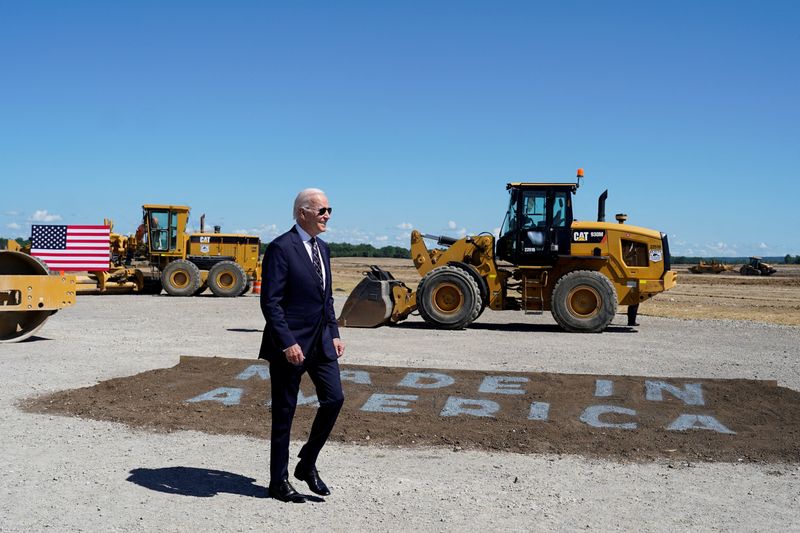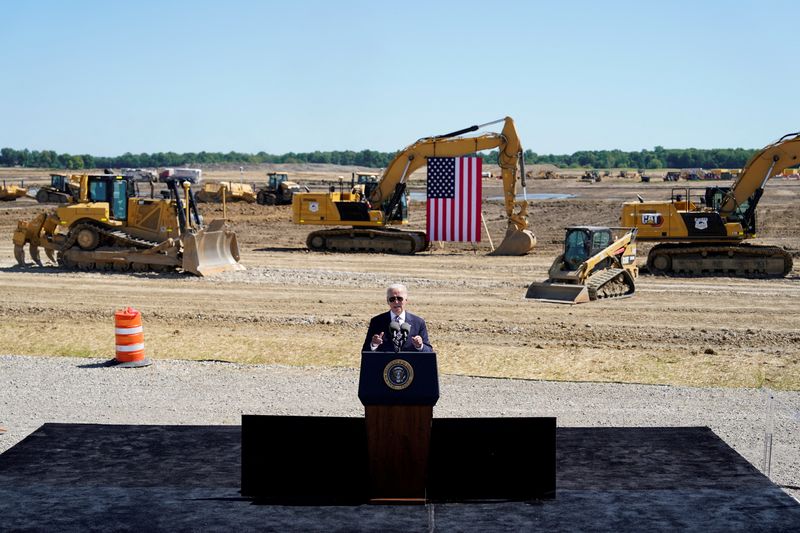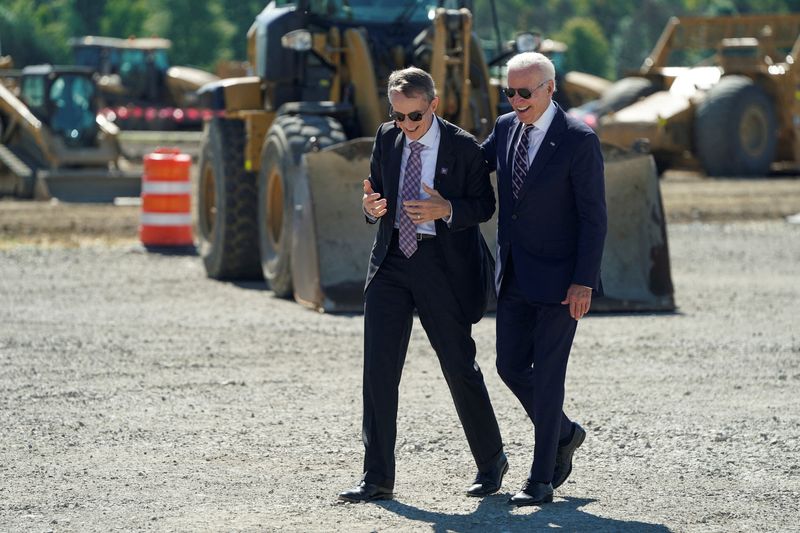By Timothy Aeppel, Ben Klayman and Nichola Groom
(Reuters) – Volkswagen’s off-road brand Scout Motors studied 74 different parcels of land across the U.S. last summer as it hunted for a place to build a $2 billion assembly plant.
It quickly eliminated almost all of them. In one case, they learned it would take six years to build a needed rail link. Others lacked access to clean power – crucial for a project for “green” electric vehicles. Some did not offer enough nearby skilled labor.
“We were hitting a deadline,” said Scott Keogh, Scout’s CEO, so they settled for a parcel in South Carolina that has all their desired features but is a bit smaller than they initially wanted – 1,600 instead of 2,000 acres.
Scout’s scramble highlights a challenge facing dozens of global manufacturers. Fueled by a combination of hefty government incentives, a transition to new transportation and energy technologies, and national security concerns about relying on distant suppliers, especially in China, there’s a factory-building boom taking place across the U.S.
But all that new construction has a real estate problem. More specifically, a “megasite” problem. While the U.S. has plentiful land, there are not that many places to quickly plunk a billion-dollar-plus factory.
The factory renaissance could soon hit a barrier because of the scarcity of ready-to-go megasites, according to 25 economic development groups, state and local officials, utilities, and companies interviewed by Reuters.
That would be a problem for the Biden administration, which has pushed through legislation to fuel the developments. Corporations have announced dozens of projects since the passage of the Inflation Reduction Act and the CHIPS Act last year.
A White House official said it was a “high-class problem” to have, adding: “Folks are finding places to build. I don’t think I’ve heard of one company abandoning plans to go forward because they’re not able to find a site.”
GRAPHIC: Industrial ‘megasite’ projects since 2018 https://www.reuters.com/graphics/USA-ECONOMY/MEGASITES/gdvzqnrympw/chart.png
AGGRESSIVE TIMELINES
There’s no single definition for a megasite, but it generally refers to a very large plot — one common threshold is 1,000 acres — tied to transport, low-cost and preferably renewable energy, and a nearby supply of skilled labor.
Local economic development agencies and states have long cultivated big industrial developments by assembling land and installing utilities in the hope of luring the next big auto assembly or steel plant with the promise of fast-track building.
Speed is often key. When electric vehicle maker Rivian Automotive Inc. was hunting for a place to build a $5 billion plant, it considered a spot just outside Fort Worth, Texas.
But the EV-maker “had some pretty aggressive timelines as far as when they needed certain elements of the transportation infrastructure in place,” said Robert Sturns, director of the Fort Worth Economic Development Department. Fort Worth could not meet those, and the project jumped to Georgia in late 2021.
The requirements on megasites can be very specific. Intel Corp’s $20 billion semiconductor plant going up in Ohio could not be situated too close to a rail line, since passing trains can create unacceptable vibrations, according to the company.
Even smaller factories can find it difficult to build quickly in this environment.
CubicPV, which makes silicon wafers used in solar panels, launched a nationwide search for a 100-to-130-acre site immediately after the IRA passed last August. They have a tight time frame, said Todd Templeton, the company’s chief commercial officer, since IRA tax incentives start to phase out at the end of this decade.
They studied hundreds of sites but constantly hit roadblocks. Some locations said it would take two or three years just to get utilities installed, said Templeton. They are choosing from two good possibilities and are aiming to have the plant open by 2025.
One site selection executive, Gregg Wassmansdorf, a senior managing director of global strategy consulting with Newmark Group Inc., estimates fewer than two dozen true megasites are still available across the country at widely varying stages of development.
“Every company, of course, wants shovel-ready megasites,” said Christopher Chung, chief executive of the Economic Development Partnership of North Carolina. “But those are more or less pretty picked over with a couple of exceptions here or there.”
GRAPHIC: U.S. manufacturing ‘megasite’ land rush https://www.reuters.com/graphics/USA-ECONOMY/MEGASITES/egpbyjzzgvq/chart.png
A POWER PROBLEM
Didi Caldwell, president of consultancy firm Global Location Strategies in Greenville, South Carolina, uses a database from fDi Markets, a London-based firm that tracks major cross-border investments worldwide, to gauge how fast demand for megasites has grown in the U.S.
According to that source, she said, there were 20 industrial projects with investments over $1 billion and a promise of creating at least 1,000 jobs announced last year in the U.S. – up from 15 the year before, and only eight the year before that.
In the decade and a half before the recent spike, the annual average was just over five and many years saw just three or four large projects announced.
One major constraint, particularly for energy-hungry factories such as battery plants, is the need for large amounts of electrical power.
“Some of these projects require hundreds of megawatts,” said Caldwell. “At the same time, we’re shutting a lot of coal plants.”
While the U.S. is investing heavily in building green power sources, those projects also face delays. A report by Lawrence Berkeley National Laboratory found that a typical project built in 2022 took five years from the initial request to interconnect it with the electrical grid to commercial operations, up from three years in 2015.
The cost and difficulty of building new long-distance transmission lines has also soared in recent years, said Rob Gramlich, president of Grid Strategies LLC, an engineering and economic analysis firm focused on the power industry.
There’s a rush to prepare more megasites. Michigan just created four. The governors of South Carolina, Virginia and North Carolina have each proposed to spend hundreds of millions of dollars on readying industrial sites in the coming years. Illinois this year will allocate $40 million in grants to prepare existing sites for companies seeking to move quickly.
But creating new megasites is inherently difficult. Environmental regulations often limit developments, local communities sometimes oppose them, and the sheer scale of the projects often require just the right mix of conditions to make it feasible.
To be sure, companies want more megasites for pocketbook reasons.
“The reason they would like more megasites, of course, is that then they could compete for better pricing” when they have more options to choose from, said Mike Tracy, principal of the Agile Group, which advises companies like automakers.
There are also the intangibles.
The VW Scout plant, for instance, is situated in clear view of a major interstate highway connecting South Carolina’s coastal regions to the upper Midwest. That means putting the Scout name, being revived by VW after four decades of dormancy, in sight of tens of thousands of passing motorists a day.
“We have a lot of people who are coming from the north or from the Midwest down that highway that would drive right by that facility as they go to the beaches of South Carolina and Georgia and Florida,” said Harry Lightsey III, South Carolina’s secretary of commerce. “That was all important.”
(Reporting by Timothy Aeppel in New York, Ben Klayman in Detroit and Nichola Groom in Los Angeles; Editing by Dan Burns and Claudia Parsons)


